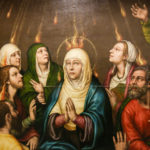Excerpted from Cultural Sanctification: Engaging the World like the Early Church by Stephen O. Presley ©2024 (Wm. B. Eerdmans Publishing Co.). Reprinted by permission of the publisher.
It is not uncommon to hear people compare our current cultural shift toward secularism with the pagan world of the early Church. In my recent book, Cultural Sanctification: Engaging the World like the Early Church, I consider this thesis and explain how the early church engaged their pagan neighbors. In this excerpt, I describe what I call a “culturally discerning spiritual life,” which explains how ancient Christians thought through every facet of their public lives. This kind of cultural discernment requires awareness of the contingences of changing cultural circumstances and the desire to seek sanctification through them, always performing and improvising in ways that were consistent their theological and moral convictions. This was no easy task, and they quickly recognized that it required them to form deep roots through catechesis and discipleship. Like the early church, I hope that we can see the need for cultural discernment to help us navigate the complex and ever-changing social world in which we find ourselves.
By the end of the second century, Christians were thoroughly entrenched within Roman culture and social life. To begin with, their numbers were growing at a rate quite unsettling to many of their neighbors. At least in North Africa, said Tertullian, Christians had spread out rapidly: “Though we are but of yesterday, we have filled all that is yours, cities, islands, fortified towns, classes of public attendants, the palace, the senate, the forum . . . nearly all the citizens you have in nearly all the cities are Christian.” Many Romans agreed, in dismay; they whined, “the State is filled with Christians—they are in the fields, in the citadels, in the islands: they make lamentation, as for some calamity, that both sexes, every age and condition, even high rank, are passing over to the profession of the Christian faith.”
Given this growth, Christians and non-Christians carried on regular everyday interactions, in the marketplace and conversations at social gatherings in public places. Pagans “came in contact with the movement in a number of casual ways,” as Nock says in his classic work on conversion, because “there was little, if any, direct preaching to the masses.” The church was not distinguished from the culture by anything in their outward appearance, especially since they were not typically found among the upper crust of society and thus blended in even more with those around them. What did distinguish them was their distinctive doctrine and practice. Christianity came on the scene with “very distinctive roots” and, though fully embedded, was never fully enmeshed in the culture.
Start your day with Public Discourse
Sign up and get our daily essays sent straight to your inbox.Public skepticism toward Christianity also produced gossip and rumors as might be expected among people living in close quarters with each other. Not everyone was attracted to Christianity; there was widespread suspicion, misunderstanding, and ridicule. This led to constant tensions between the pagan and the Christian communities that played out in daily interactions. Refusing to worship pagan gods, Christians were subjected to various forms of interrogation. They were excluded from public places; ultimately, some were tortured and killed for their convictions. This hostility escalated in the times of Decius, Valerian, and Diocletian, as these emperors tried to bring unity to the fractured empire. Christian theologians often discussed how pagans charged them with all kinds of outlandish arguments. They “regard us as a human herd cut off from other people,” Tertullian said, and Minucius Felix’s pagan interlocutor suggested that Christians were a “shadowy and cunning race, silent in public, but chattering in lonely corners.”
Obviously, Christians were making a name for themselves, and the church had to live with the negative consequences. But how did they do so? How did early Christians think through the challenges of living in a world marked by temples to idols on every street and an economic system fueled by idol worship? They had to undertake a process of resocialization, cultivating a cultural discernment in every aspect of their own spiritual lives.
The post-conversion challenges facing Christians arose when they reentered society as baptized people and navigated the conflicts raised by their new convictions. This process demanded a culturally discerning spiritual life. In their post-conversion resocialization, those who came up out of the waters of baptism had to navigate the pagan world by a new set of convictions. They encountered their neighbors in a new perspective and had to weave new patterns of social engagement so as to live faithfully in light of their theological and moral convictions. And they had to do so in ways that made the Christian life a living testimony to the moral beauty of the gospel . . .
The church is never reserved to one people or one political system. The early Christian apologist Aristides, for example, argued that the Christian community formed a new ethnos, a new people, distinct from Greeks, Babylonians, Egyptians, and Jews. While these groups might in varying degrees approach the truth, only Christians “have come nearer to truth and genuine knowledge than the rest of the nations.” New Testament scholar Wayne Meeks compares Aristides’s discussion of conversion to the ethnos of Christianity with the experience of immigrants who leave their native land and need to adapt to a new place and a new way of life. He defines the “resocialization” of the reenactment in a new setting of “the primary socialization that occurs normally in the interactions between child and family, the process in which the self receives those components of its structure and those basic values that are contributed by its environment.” Just as a child is reared and guided with the morals and the values of its family and then grows to maturity and enters society, so also is the Christian discipled and guided in the distinctive theological and moral assumptions of the church and matures to live Christianly in the world. This resocialization, however, is built upon different theological assumptions and maintains distinctive moral convictions so that those who convert begin following new cultural and moral patterns of the Christian life.
In social sciences, the concept of resocialization is related to the notion of acculturation, “the changes that arise following ‘contact’ between individuals and groups of different cultural backgrounds.” For ancient Christians, this became a dynamic process in which the elements of their Roman identity were filtered through their Christian morality, like separating the wheat from the chaff. Meeks says that “for the vast majority, the Christian life was an amphibian life, life at the same time in the old world that was passing away and in the new world that was coming.” Christians were “moving back and forth between the two sets of social practices” in accordance with their moral sensibilities. A key passage that helped shape this kind of movement was Matthew 6:24: “No one can serve two masters, for either he will hate the one and love the other, or he will be devoted to the one and despise the other. You cannot serve God and money.” This text addressed much more than taxes; it called for a holistic framework by which the church could undertake the life of cultural discernment. The service of two masters had to be carefully regulated and deciphered, particularly in terms of forming habits, mores, and customs. The early church assumed that devotion to Christ necessitated that their process of cultural absorption be governed by their choice to follow Christ within the culture in a way that was faithful to Christian morality.
The post-conversion challenges facing Christians arose when they reentered society as baptized people and navigated the conflicts raised by their new convictions. This process demanded a culturally discerning spiritual life.
The process of Christian acculturation happened at both the personal and institutional levels. On the personal level… Christians were challenged to live moral lives among their neighbors so as to display their good works to others through social interactions. For many, this kind of witness manifested Christian virtue in all aspects of life, not least by the kinds of social interactions that Christians refused. Alongside personal interactions, acculturation also happened at the institutional level where the church viewed itself as a family, an organic body manifesting the work of God within creation. That community would be, for example, devoid of any association with paganism. As such, their gatherings, rituals, morals, and culture would be quite distinct from those of any other social or political organization. For this reason, the clergy had to remain committed to the task of organizing and leading the church, because if the “deacons, and presbyters, and bishops” turned their backs and ran, Tertullian writes, “who of the plebs will hope to persuade people.”…
How were they to seek holiness in their world? In the early second-century text called the Didache, we can see the process of cultural discernment in action. The text describes how to welcome newcomers into the community:
Everyone “who comes in the name of the Lord” is to be welcomed. But then examine him, and you will find out—for you will have insight—what is true and what is false. If the one who comes is merely passing through, assist him as much as you can. But he must not stay with you for more than two or, if necessary, three days. However, if he wishes to settle among you and is a craftsman, let him work for his living. But if he is not a craftsman, decide according or your own judgement how he shall live among you as a Christian, yet without being idle. But if he does not wish to cooperate in this way, then he is trading on Christ. Beware of such people.
Sojourners among the Christian community were welcomed and supported, but that support was limited; those who wished to join the community had to take up an occupation. If not, the community had to discern how to maintain them without fostering idleness.
We find a more detailed account of cultural discernment in Hippolytus’s tract On the Apostolic Tradition. This text tells us that anyone interested in joining the church had to go through an initial interview to ferret out potential problems in their lives or backgrounds. Newcomers were “questioned concerning the reason that they have come forward to the faith” and “questioned concerning their life and occupation, marriage status, and whether they are slave or free.” While many vocations were acceptable, any involving sexual immorality, pagan religious offices, or gladiatorial games had to be abandoned before the candidate could proceed further. Some others, such as teachers or military personnel, might continue their work with some cautioning and qualification. The same kind of sifting is also evident in Tertullian, who tied everything back to the problem of idolatry: “no profession, no trade, which administers either to equipping or forming idols, can be free from the title of idolatry.” Christians had to think carefully through every aspect of their lives, examining their vocation to see how it might influence their spirituality; as Greer argues, “theology in the early church was always directly or indirectly concerned with the common life of Christians.” The intersections of the common life were precisely where the tensions between the Christian and pagan ethical concerns became manifest.
For contemporary Christians raised in the seeker-sensitive movement, this kind of personal interrogation of potential new members may seem a bit shocking. Early Christians did not immediately welcome just anyone into the church; the church’s identity and purity needed to be safeguarded and preserved through a slow, steady, and deliberate process. The early church played the long game and grew slowly. There were no dramatic mass conversions, only a work of church planting that attracted locals through casual contacts and everyday interactions. This was a revolution marked by “gradualism” and proved to be the “ultimate factor” that led to the rise of Christianity, says sociologist Rodney Stark. The “central doctrines of Christianity prompted and sustained attractive, liberating, and effective social relations and organizations,” steadily undermining the Roman patterns of culture. It grew naturally out of the Christians’ dual citizenship. The moral of the story is that the “Christian can be neither fully involved in his society nor fully withdrawn from it. Instead, he must keep his sights on the pilgrim’s path.”
Image by WavebreakmediaMicro and licensed via Adobe Stock.














